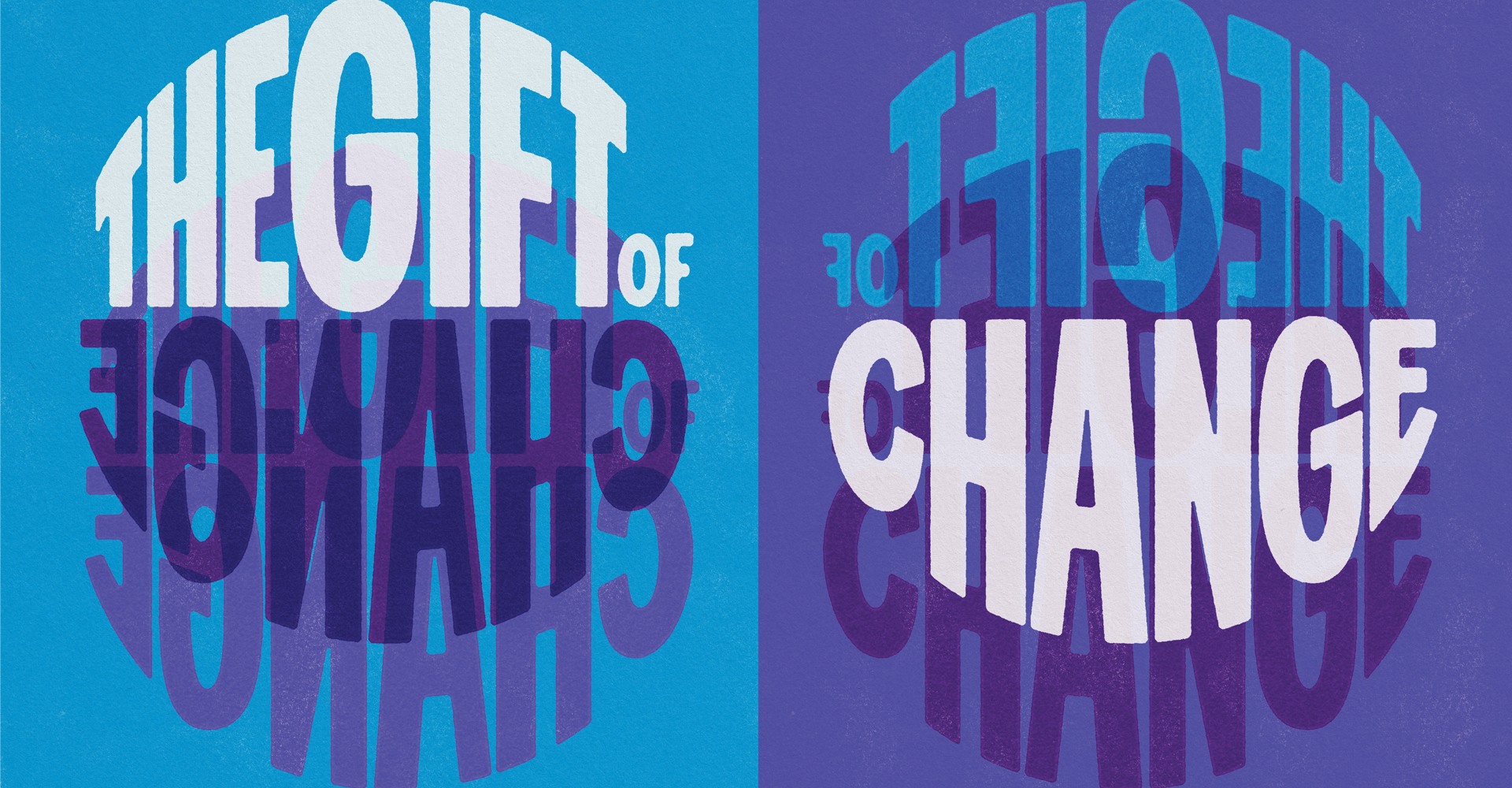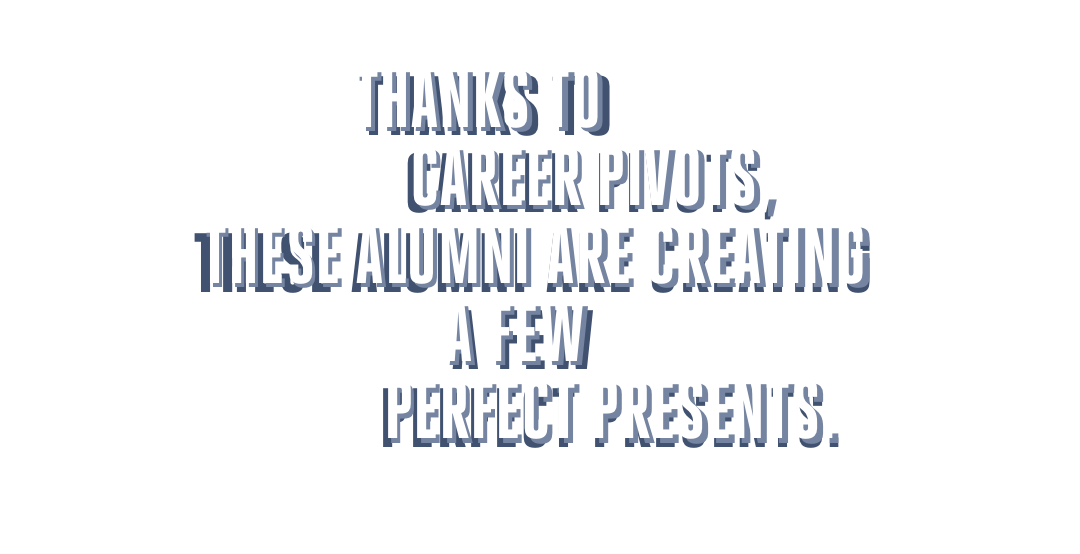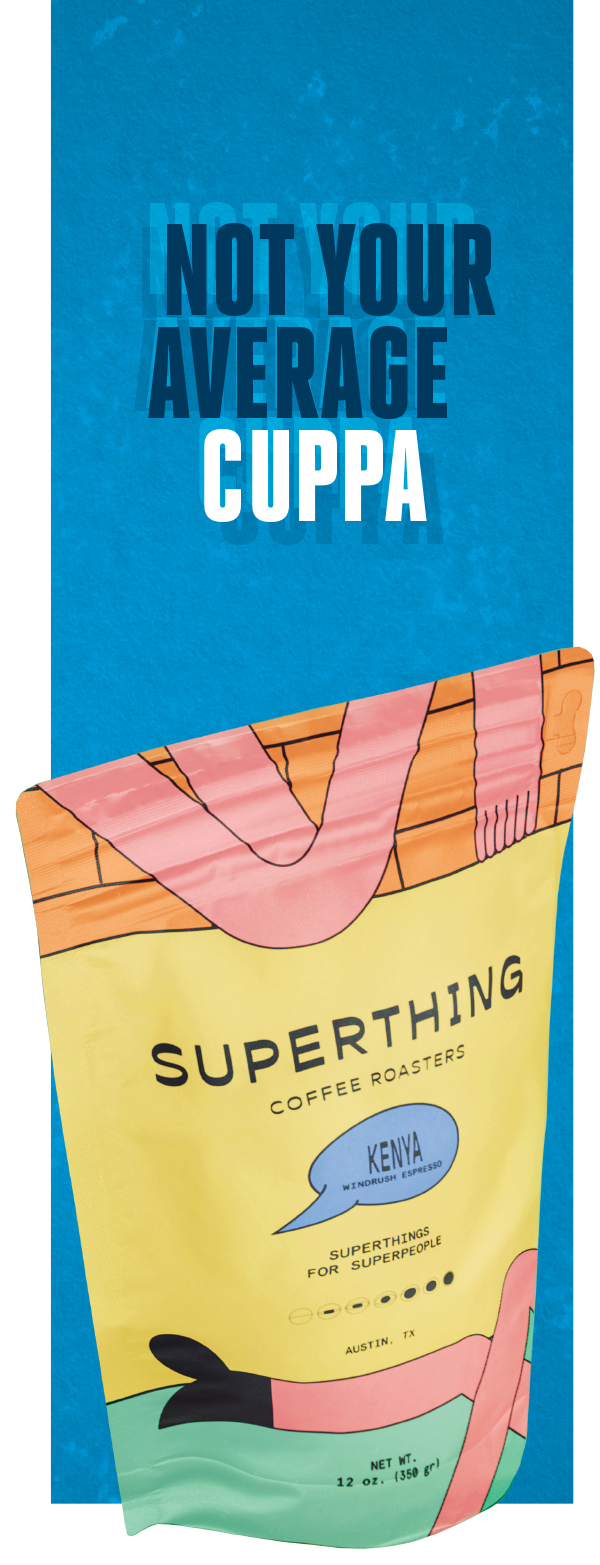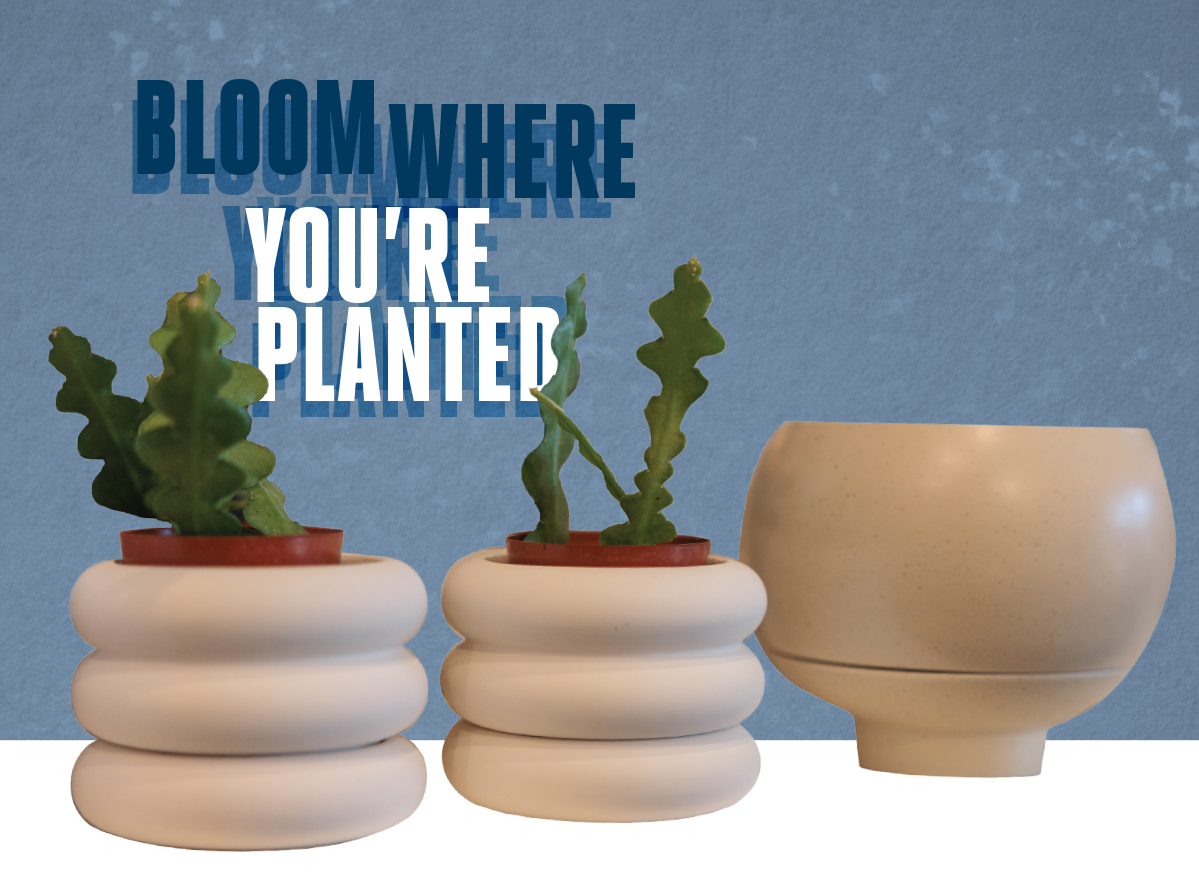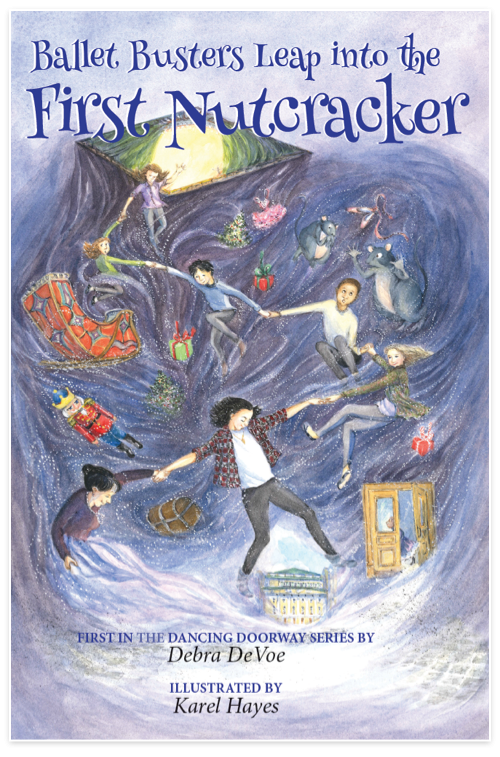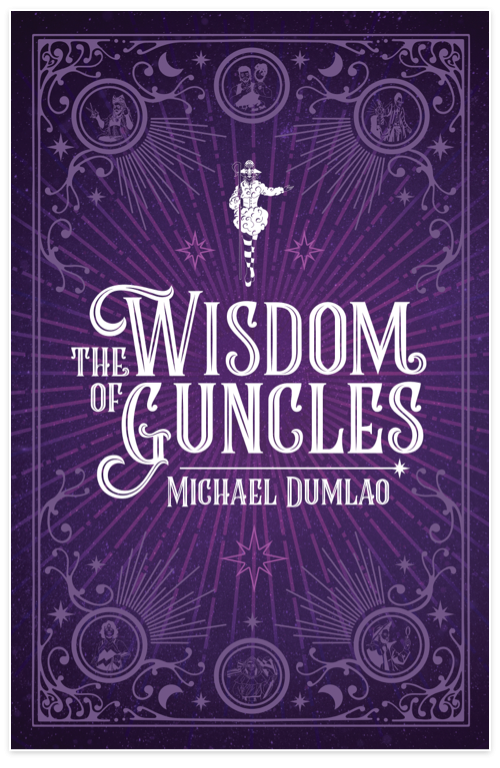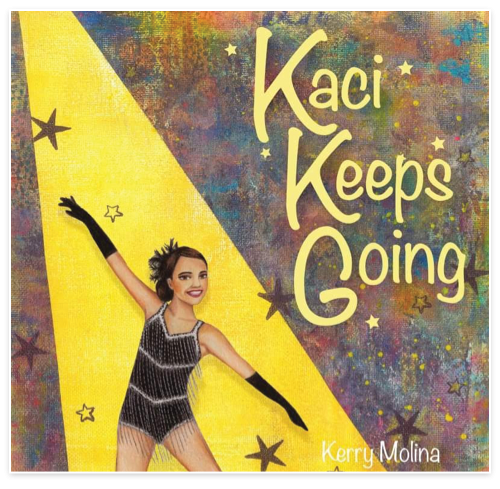The Gift of Change
The paths we set out for ourselves don’t always end up where we imagined. Sometimes they lead to ice cream. Or jewelry. Or even plants. Each of the seven alumni in this year’s gift guide pivoted from their area of study to a passion project that became their career, and in the process delivered something good enough for gifting, from an obscure bottle of Burgundy to a luxurious moisturizer. Thank goodness for second chances.
It was during her senior year at the Elliott School of International Affairs, while interning for CNN between classes, that Ana Mari Ortega Schwarzberg, B.A. ’08, decided she needed to find a way to unwind. A lifelong crafter, she reached for a knitting kit when her then boyfriend (now her husband) suggested she try learning to make jewelry instead. He bought her a few tools, and she found a metalsmithing studio in Bethesda where she could learn some of the basics. “The rest, as they say, is history,” she says.
She launched her eponymous jewelry line in 2008 after enrolling at Miami International University of Art & Design. She doesn’t remember what kicked off the first collection—she assumes it was a gemstone necklace, given that’s what she remembers feeling inspired by at the time—but one thing she knows for sure is that it was in her signature style: a mix of color, texture and form, but always classic.
“I gravitate a lot toward pearls, but I try to create styles that are a bit more modern and inventive,” Ortega says. “I also love color and love mixing different colors, materials and textures. You can really see this in my orchid earring collection.”
The orchid earrings—dimensional polymer clay petals in the shape of a black, turquoise, green or pink orchid atop a coordinating bead drop—are a personal favorite of the designer, the most unique item in her collection and one she always keeps in stock. But Ortega is constantly designing (“I love going to gem shows and buying different stones and beads and just playing until I come up with combinations that I love,” she says), and over the fall and holiday seasons will release about 60 new items, with multiple launches each month.
“I try to keep adding new and fresh designs while keeping a core collection of my classic and bestselling pieces,” Ortega says. In short, she just tries to design pieces that she would like to wear but can’t find in the market, like her three-pearl drops (three freshwater pearls strung on delicate gold-plated silver chains) or her double flowers (a small mother of pearl flower attached by post to a larger one), both bestselling earrings.
The switch from international affairs to jewelry design was unexpected, but she says it was the right decision for her. And, it turns out, the two vocations did eventually overlap.
In 2022, along with her collaborator and friend, Vanessa Fernandez, Ortega received a commission from the White House to design a custom piece for the Spouse Program of the 2022 Summit of the Americas in Los Angeles. It was an unexpected intersection of her area of study at GW and her creative career—but one that was entirely welcome.
Says Ortega, “It brought my design experience full circle with my education from the Elliott School, as I was creating diplomatic gifts for foreign leaders who attended the event.”
Ana Mari Ortega
anamariortega.com
Use code GW for 15 percent off your next order.
Courtesy of Ana Mari Ortega
Cajou Creamery co-founder Nicole Foster, B.A. ’93, M.P.H. ’98, was in law school studying to become a criminal defense attorney when she decided to become a raw vegan. She noticed how, compared to consuming a standard American diet, eating cleaner helped her body—and her mind—perform better. Cut to her and her husband starting a family and learning that their two sons were lactose-intolerant.
“We couldn’t imagine telling our kids, ‘You can't eat ice cream for the rest of your life,’” Foster says. So they decided to make their own. Foster earned a raw food chef certification and, in the process, learned to make nut milks and developed a very rough recipe for a dairy-free ice cream—one they’ve adapted but still use in their Baltimore café today.
Of course, making ice cream for friends and family (and one client, D.C.-based Glen’s Garden Market) on a machine that only churns three pints at a time—the only piece of equipment they had when they launched in 2016—wasn’t sustainable. They joined a commercial kitchen in D.C. and eventually relocated the entire operation to Baltimore, where in 2021 they opened a brick-and-mortar store after winning a retail storefront competition.
It’s there that they serve a selection of their signature flavors inspired by their travels, like baklava and blueberry cheesecake (two fan favorites), as well as new launches.
To celebrate the shop’s one-year anniversary, for instance, Cajou introduced its Blame it on the Boogie collection, an homage to Michael Jackson’s 1970s hit. Sunshine (a creamsicle flavor), Moonlight (milk and cookies), Good Times (tiramisu) and Boogie (a CBD-infused raspberry bellini) all top Foster’s current list of personal favorites (with perhaps a slight bias for Good Times: “I ate so much of it yesterday,” she admits), and each of them features the creamery’s signature cashew milk-based recipe.
Why cashews? For a few reasons, says Foster. First, cashew milk is creamier than other alternatives and doesn’t impart a distinct flavor. Plus, cashews have a lot of health benefits. Known as nature’s vitamin pill, they’re packed with fiber, carbs, proteins, unsaturated fats, minerals and then some. What’s more, making cashew milk is zero waste. Unlike almonds or coconuts—where there’s a husk left over after milking the nut—the entire cashew (cajou in French) can be used in the process.
Foster serves as Cajou’s CEO while continuing to practice law, and the creamery benefits from her decades in the legal industry. Recognizing that those with prior arrests often have a difficult time thriving after they return to society, Foster built Cajou Creamery as a worker-owned co-op that hires folks returning to the workforce.
“We want to provide not only a job but an opportunity at ownership,” Foster says. “That’s where the real opportunity to transform your life comes from.”
Foster just wants to better lives through ice cream, whether that’s improving one’s circumstances or curbing a craving.
“The other day, somebody came into the store and cried,” Foster says. “She’s like, ‘I feel seen because normally you go to ice cream shops and there's one vegan option, right? But this is entirely dedicated to me.’ I was like, ‘Oh my God, that’s amazing.’”
Cajou Creamery
cajoucreamery.com
(Whole Foods or, for locals, the Howard Street café) Use code GW2010 for 10 percent off your in-store purchase through Jan. 1.
From Meghan Trainor’s “My Kind of Present” music video and Kasey Musgraves’ original film, “Star-Crossed,” to a live Coachella performance with Princess Nokia, Victoria Walls, B.B.A. ’16, has plenty of professional dance credits to her name. She often finds herself in long rehearsals, in front of a camera or even on a stage (in other words, sweating in a full face of makeup), so she knows what it feels like to be tough on your skin. Which is why, during the pandemic, she started experimenting with something she’d long been interested in: skincare.
“I began to research and understand what types of products I enjoy using and what type of products are beneficial for your skin,” she says.
It was a bit of a switch for the dancer, but she was used to sharp turns. After graduating from GW with a degree in event management, Walls wondered if her 9-to-5 was keeping her from her true passion—dance. She’d been on GW’s first ladies’ dance team and was a member of D.C.-based dance team Capital Funk. Walls decided she wasn’t ready to give it up, and in June 2018 moved to Los Angeles.
“By January 2020, I was on stage dancing at the Grammy Awards,” she says.
That was the same year she launched The Skin You’re In, a line of products designed for all skin types to feel hydrated and glowing. She teamed up with a manufacturer (“so that my products are protected by the FDA and always safe,” she says) to create vegan, paraben-free formulas for four core products—an oil cleanser, moisturizer, charcoal mask and tea face mist—then spent a few months testing the products on friends and family of differing ages and skin types.
The charcoal mask—her bestseller—feels like “a spa day in a jar,” she says, but her personal favorite is the moisturizer. “I love that I can feel hydrated without a heavy moisturizer,” says Walls. “It doesn’t leave a greasy finish.”
She uses each of her products daily, starting with the oil cleanser to remove makeup, then following it up with the daily cleanser, a foaming face wash that she introduced in January 2021.
Since her nearly sold-out launch in June 2020, she’s added even more products to the company’s recommended beauty routine, including limited-edition serums and, a current favorite, a lavender sleep mask (“It smells amazing and deeply hydrates the skin while you’re sleeping,” she notes).
Walls says The Skin You’re In differs from other skincare brands because it extends beyond skin into the realm of self-care. “Whether you wear the face mask while enjoying a glass of wine or come home from a long day and use the lavender sleep mask before bed,” she says, she just wants The Skin You’re In to leave a lasting impression.
The Skin You’re In By Victoria Walls
theskinyoureinvw.com
Use code GW2022 for 20 percent off your order.
Courtesy of Victoria Walls
Nick Krupa, B.A. ’00, remembers the first cup of coffee he had that truly blew his mind: It was in 2005 at San Francisco’s Ferry Building Farmers Market. Long a destination for chefs, foodies and farmers alike—Chez Panisse’s Alice Waters says she shops there weekly—the market had drawn Krupa and his business partner, Andy Wigginton, while on a tasting mission. They noticed a huge line (“always a good sign,” Krupa says) stretching to the Blue Bottle Coffee kiosk.
“We ended up trying a latte, and it was unlike anything we had ever tasted,” he says. “Espresso and milk together, without being burnt or over-extracted, was a revelation.”
The Oakland-born coffee company was among the earliest “third wave” outlets—that is, coffee for consumers who understand their morning cup of joe is the result of a long supply chain that includes a producer, importer and roaster, not just a barista—and Krupa says they were determined to bring some of that magic back to Austin. They just weren’t quite sure how yet.
At the time, Krupa and Wigginton were both a couple of decades into their careers and starting to feel a pull toward something new. Namely, coffee. So in 2010, finding themselves between tech gigs (Krupa was a software developer, which he jokes was a “natural parlay” from his degree in international affairs), they opened Patika, a pint-sized coffee truck in Austin’s Warehouse District that eventually earned its own long lines and a cult following after its specialty brew. Four years later, they decided to take the leap to a brick-and-mortar location, closing the cart but still emphasizing the coffee. It was there that Patika’s two managers, Kyle Smith and Tony Smith, started getting super into roasting. So they approached Krupa and Wigginton with an idea: Why not start a roastery?
In 2019, the four launched Superthing Coffee Roasters, a small operation based just outside of Austin in Dripping Springs. “We tell people, ‘Just drive out west until you start seeing horses and then take a left and follow the giant pink eyeball. We’ll be there,’” Krupa says.
If it sounds a little fanciful, that’s because it is. Superthing’s whole aesthetic is a vibe—from the typeface to the tasting notes. Because the roastery chafes against the experience of coffee as "serious business" (even though it obviously takes coffee seriously), the packaging features surrealist graphics from Mexico City-based designer Futura, a universe of cycloptic creatures and portals set against colorful backdrops. The flavor descriptions (like this one for their Ethiopian-Columbian Tractor Beam Blend: “Wah Wah Wah Wah Wah...that's supposed to be a tractor beam sound. We wanted to design a blend that is well-rounded for espresso and filter coffee that brought a little bit for everyone. Also, we couldn’t resist any excuse to call the espresso shots ‘tractor pulls’”) are fun, irreverent paragraphs that make you feel cool just for wanting to drink the coffee, even if you haven’t yet.
“We were trying to do something where every aspect of the design and packaging—flavor descriptions, coffee names, all of it—is ‘turned up’ all the way,” Krupa says. “Coffee branding can be so stark and serious, and we wanted a completely different direction.”
As for the coffee itself, it’s super. Customers dig the roaster’s original Power Blend (“pretty spectacular on espresso,” Krupa says), but the co-owner himself prefers a Costa Rican from Tarrazu that Superthing calls San Diego. It’s not always in season, but when it is, it blends a traditional Central American coffee taste with undertones of blueberry, raspberry and dark chocolate. Krupa calls it “exceptional.” In other words, it might just be the cup that blows your mind.
Superthing Coffee
superthingcoffee.com
Use code SUPERGW for a one-time discount of 25 percent off (subscriptions not included!) through the end of 2022.
Courtesy of Superthing Coffee
Any chef worth her salt knows: You have to taste as you go. And although she’s self-taught, Mei-i Zien, B.A. ’99, heeds the advice. The twist? She makes dog treats.
“I have tried everything that has come out of the oven at least once, even the dog biscuits,” says the maison de pawZ owner. “All the treats smell delicious and look tasty.”
Zien was working 9-to-5 behind a desk in a D.C. think tank when she decided that wasn’t what she saw for her future. She pivoted to fashion and spent the next 18 years heading up sales divisions and leading global brand launches. It was around that time that her sister’s American Eskimo puppy, Tyler, decided he belonged to Zien, not her sister. But when he was 7 years old, he started developing skin allergies, which led to a year of constant vet visits.
“That was when I decided to take full control by completely rehauling his diet,” she says. She started making his treats at home, and for Tyler’s 8th birthday, baked him a special cake and birthday biscuits. When a guest jokingly suggested she was running “maison de pawZ,” the name stuck.
For several years, Zien ran the “pawtisserie” as a side hustle, squeezing in baking on the weekends and in her free time. But when CB2 placed an order large enough that she had to gather a group of girlfriends to help with packaging, she knew she had to pivot once again.
She committed to maison de pawZ full time and, just before the pandemic, moved her operation from the city to a commercial kitchen in New Jersey. Zien set to work fine-tuning recipes and expanding her product line from the three original biscuit flavors—Croque Monsieur (ham and cheese), Spiced Apple Tart (apples and honey), and Je T’Aime Veggies (beets, carrots and kale)—to include a few other flavors, each 100% human-grade, with zero preservatives, and utilizing local ingredients. She sources organic flour from New York-based Farmers Ground, sugar-free peanut butter from Big Spoon Roasters in North Carolina, beef marrow bones from local craft butchers for steak frites broth, to name a few.
“We use only the very best ingredients for our dogs because we want to know they are eating the best,” Zien says. “So even if the treats sound decadent and look over-the-top, our most sensitive stomachs and allergic dogs are able to enjoy them safely with zero rumbly tummies.”
What sets maison de pawZ apart from other, similar companies? Zien says she doesn’t take shortcuts. When she makes blueberry filling for the pup-tarts, for instance, she uses just blueberries, honey and beef-bone-broth gelatin (never store-bought).
“Every item is completely all-natural and preservative-free,” Zien says. “I use a slow-and-low bake process to remove the moisture from the dog biscuits so that it is shelf-stable for up to a year. The low bake also helps preserve vitamins and minerals In the ingredients.”
The “barkery” also offers special treats for local clients, taking custom orders for cakes and partnering with a New York City-based bakery to stock pawtisserie items with a shorter lifespan, like dog donuts and cookies.
Zien says the cakes are her favorite item on offer—she’s collaborated on custom projects and events for numerous global Fortune 500 brands—while her canine clients prefer the steak frites biscuits.
But none of the products get past her bosses, Tyler and her long-haired chihuahua, Marcel, without their lick of approval.
“They have very discerning palates,” she says.
maison de pawZ
maisondepawz.com
Use code RAISEHIGH for 20 percent off your next order.
Courtesy of Maison de pawZ
As a restaurant sommelier in New York and D.C., Mike Zima, B.A. ’10, sometimes had to serve wines that he wasn’t 100 percent excited about—that’s just the nature of the game. But the other side of the coin (or the cork, if you will), is that there were also wines he couldn’t wait for guests to try—wines that felt exciting and special and, in some cases, rare. It’s those wines, says his wife and business partner, Azziza BenSaid, B.A. ’10, J.D.’13, that inspired him to start SommPicks.
“The jumping-off point was a guy that came into Del Posto [where Zima was working as a somm] and ordered a three-liter of 2001 Sassicaia [a Bordeaux-style red],” Zima says. “He loved it and asked if I could find him more. I did, and he bought it all, so I thought, ‘Wow, this could be a business.’”
Zima launched SommPicks in 2012, hoping to bring high-value wine to the masses—both serious oenophiles and those just starting their wine journey who want to taste something exciting.
That means that the couple (BenSaid joined as the company’s COO in 2015, looking for a change after a career in law) sells, quite simply, wine that Zima likes.
“What he has tried to do is only present wine that he feels like he can stand behind,” says BenSaid. To do that, pre-pandemic, the couple would travel to Europe once a quarter to taste and select the wines they’d offer through SommPicks, often trying to pay special attention to smaller-production wines and winemakers. They hope to start traveling again soon, sourcing their signature Old World offerings from France, Italy and Spain (and then some).
“A lot of what we’re selling is kind of more fine and rare esoteric wines,” BenSaid says. “For example, older vintages and wines that are made in minuscule quantities tend to be harder to find locally. That’s really why we're bringing them in from Europe.”
The website sommpicks.com works like any direct-to-consumer site. You log in, select the wine you want—prices range from $21 all the way to more than $10K for “super old/rare/unique formats”—and checkout. Depending on where the wine is (SommPicks lists wines for sale even if they’re in pre-arrival, a.k.a. purchased but not yet on a boat headed for the company’s San Francisco warehouse), and where you are, you could have your order later that day (in the Bay Area) or, in the case of pre-arrivals, in up to 14 weeks. If that seems like a long wait, that’s because it’s one way the company continues to offer reasonable prices: Consolidating shipments means lower freight costs. When most of your product travels across the pond, that’s an important consideration.
The inventory grows each month when the company launches a new “collection.” The late summer list added more than 750 new wines to the lineup, for instance, including new offerings of their bestselling varietals, burgundy and champagne.
Take, for example, Clement Perseval and Jacques Selosse, two complementary producers in SommPicks’ inventory. On the one hand, Selosse is well-known in the wine world and has somewhat of a cult following, while Perseval (who worked with Selosse for years) produces a champagne that, to many, is every bit as good but available for a fraction of the cost.
“This is a great example of what we try to do at SommPicks,” BenSaid says. “We love working with well-known names like Selosse, but we also love to be able to say, ‘Hey, if you like Selosse, you should really check out Clement as well.’”
A true wine nerd, Zima is happy to direct a customer to their next favorite bottle—and he’ll even help customers track down a wine that’s been stuck in their memory for years.
“That's also a service that we provide,” BenSaid says. “It’s something my husband loves to do because it's kind of a challenge, and people looking for random bottles like that tend to be really interested in wine and passionate about what they're looking for.”
Passion is the purpose of SommPicks, when it comes down to it. As BenSaid says, they just sell wines they’re excited to sell.
SommPicks
sommpicks.com
Use code FOGGYBOTTOM for 5 percent off your order until the end of the year.
Courtesy of SommPicks
Shortly after grad school, Anna Johnston, M.P.H. ’14, realized something: She’d spent a lot of time in school, but she had never picked up any hobbies. Unnerved by the realization, she started buying plants.
“My grandmother used to have houseplants when I was little and she showed me how to take care of them,” Johnston says. “I felt like I knew the basics.” Her next steps grew (no pun intended) from there.
She launched Jungle & Loom—so named for the items she was selling at the time, plants and fiber art—on the side while pursuing a career in public health until, two years later, in 2020, she transitioned it to a full-time business. These days, Jungle & Loom has blossomed into two locations—one at D.C.'s Union Market and another, the flagship, in the Brookland Arts Walk.
“That is a really special location because I have the privilege to be neighbors with some of the best creative folks in the D.C. area,” Johnston says. “We are all open on Saturdays to sell our goods.”
For Jungle & Loom, that means everything from playful plant stickers and macrame wall hangings to vintage glass and, of course, live plants. Johnston says her bestsellers are the staples—pothos, ficus, sansevieria—especially for folks just getting into plant parenthood, as so many did during the pandemic. But she notes that planters are just as important as what goes in them, so she makes sure to stock a range of types and sizes to satisfy both form and function.
“It is absolutely my mission to help people find the plant that works best for their home situation, lifestyle and plant-parent style,” Johnston says, “but I also want you to feel good about it. I want it to be a beautiful addition to your home.”
The shop offers services that go beyond plants and home accessories—repotting services, virtual consultations, group and private workshops, as well as greenery rentals and installations at events. Basically, if a customer dreams it up, Johnston is usually amenable to making it happen.
“The evolution over time was partially directed by my interest and partially directed (probably more so) by customer requests,” she says. “If a customer asked, ‘Can I…’ or ‘Can you get…,’ I have always done my best to say yes if it made sense for me as a business decision.”
Her willingness to adapt means she often has a lot going on, and the list is ever growing. But the proof is in the pudding (potting?). With so much in the works—new locations and products, a slight rebranding, updating the website—it seems her instincts are paying off.
Jungle & Loom
jungleandloom.com
Use code GWLOVESPLANTS10 for 10 percent off your online purchase.
William Atkins
Alumni’s recently written and illustrated books may be the perfect stocking stuffer, many for the young and young at heart.
Like the alumni featured in this year’s gift guide, these five authors also took a few left turns, be it returning to a forgotten story from their past or switching media altogether.
Ballet Busters Leap into the First Nutcracker
by Debra DeVoe
$10.99
dancing-doorways.com
Tiny Travelers
Debra Ann DeVoe, M.A. ’82, loves to dance. She took her first class at 3 years old, began helping her teacher lead other dancers at 13, and by her senior year of high school was teaching her own class of preballet students. In her spare time, she devoured books about ballerinas, dance history and ballet stories. When she went off to college, she continued the obsession.
“Working with Maida Withers and Nancy Johnson during the early ’80s at GW, I expanded my knowledge of dance beyond technique,” says DeVoe, currently a dance teacher based in Maryland. “I delved into dance philosophy, criticism, dance history and research.”
It was only natural then that in 2018 she penned her own children’s book, “Ballet Busters Leap Into the First Nutcracker.”
The story follows Marti, Julie, Zack, Luis and their dance teacher, Miss Sophia, as they travel to St. Petersburg, Russia, in 1892, to witness the first staging of “The Nutcracker.” DeVoe says she noticed a lot of dance picture books on the shelves, but not many chapter books for grade school students. So she wrote her own, creating fictional characters but taking some inspiration from her own life.
During an improv dance course with Withers, for instance, her class was walking past the Kennedy Center and saw famed choreographer George Balanchine standing outside.
“[Withers] went up to him, shook his hand and introduced all of us, thanked him for his work, and he signed the sole of her dance shoe,” she says. “Balanchine had performed as a child in one of the early Nutcracker performances in Russia. In my books, the children leap back in time and work with famous dancers from long ago. Maida taught me you can meet and learn from great people in the world of dance.”
The Wisdom of Guncles
by Michael Dumlao,
illustrated by Kyle Marcus Bryant
$14.99
thewisdomofguncles.com
Wiser Words
It was while singing together in the Gay Men’s Chorus of Washington, D.C., that author Michael Dumlao and artist Kyle Marcus Bryant, B.F.A. '18, struck up a friendship—both personal and professional. Dumlao, who had just penned a book of queer insights, was searching for an illustrator and had seen Bryant posting his work on social media. Though Bryant had never illustrated a published book before, his style was exactly what Dumlao was looking for.
“I think it was also important to him to work with a queer artist of color,” Bryant says, “as the book tells the true stories of a diverse group of LGBTQ+ people.”
“The Wisdom of Guncles” shares 10 journeys from a collection of gay uncles (“guncles”) and other queer guides, told through varying archetypes—the Nerd, the Skeptic, the Elder, among others. With input from Dumlao, Bryant illustrated each of the narrators at the start of the chapter. The Alchemist, for instance, tells the story of a queer, non-binary drag artist from Paraguay struggling with their immigrant parents’ expectations. Eventually, they create the safe space they never had and give their niece the confidence to come out. Bryant illustrates them sitting assuredly in a salon chair, robe overflowing, with a fading transmutation circle in the background.
Bryant says that, while he doesn’t have a guncle nor is he a guncle himself, the stories in the book were so universal—”triumph after tragedy, risk and reward, selflessness and sacrifice and duty to your family”—that he was able to relate to something in each chapter.
“I actually cried like a baby while I read it,” he says.
Kaci Keeps Going
by Kerry Molina
$12.95
kerrymolina.com/my-book
Do Hard Things
There’s no pressure like the pressure we put on ourselves, and Kerry Molina, M.A. ’96, knows that all too well. As a teenager, Molina (née Christiano) had prepared all summer for her upcoming live dance performance during the Miss New York State pageant. She was the youngest contestant, from a very small town, but she’d secured a spot in the top 10.
Once she was on stage, though, as she began to make her way through the routine, the lights and the eyes of the audience began to throw her off her game. Suddenly, she forgot the steps. But Molina persevered, making her way through the performance despite the falter, and eventually was named fourth runner-up.
Years later, she retold the story in a personal essay class in college and knew she wanted to turn it into a children’s book. In 2018, she penned “Kaci Keeps Going,” about a young dancer named Kaci (K.C., for Kerry Christiano) who works hard not to let her nerves get the better of her during a solo dance performance.
Molina, whose Yellow Brick Road Studio in Gainesville, Virginia, offers art classes for adults and children, says the book champions the power of positive thinking.
“The messages of perseverance, hard work and a growth mindset are so important to impart to kids,” she says.
Historic Buildings of Washington, D.C.:
A Coloring Book of Architecture
by Scott Clowney
$8.50-14.95
scottclowney.com/Historic-Bui…gs-of-Washington-D-C
Fill in the Blanks
Browse the website of artist Scott Clowney, M.A. ’11, and you’ll see a somewhat disparate collection of his work: illustrations titled “Skulls” and “Death in the Evening” mix with line drawings of beautiful buildings, from Hampshire House in Boston to Carnegie Library in Washington, D.C. But a person contains multitudes, and, as an artist, he goes where the inspiration—or the lack of it—leads him.
“After the coloring book series, I struggled to draw—even doodle,” Clowney says. “This ‘artist’s block’ had a negative impact on my mental health and well-being, and I slipped into a period of sustained, self-sabotaging doubt. One day I just decided to tap into all that uneasiness. I sifted through my archives and began creating new work around themes of light and dark, but mostly darkness.”
Clowney says he’s more productive these days than he ever has been, but architecture is his true love. Currently the director of exhibitions and public programs at the District Architecture Center, Clowney says he’s long had a passion for striking spaces that shape a city skyline. In 2017, he teamed up with the National Building Museum to create “Historic Buildings of Washington, D.C.: A Coloring Book of Architecture,” celebrating the form of the White House, Union Station and other architectural landmarks.
“My hope was [those who buy the coloring books] would be enticed by the challenge or proposition to stay within the lines or break free from the extreme constraints, whatever their fancy,” Clowney says.
He’s added three more books to the collection in the years since (including one set to release in 2023, featuring San Francisco), each hand-drawn building accompanied by a paragraph on the history of the structure, inviting the viewer to add her stamp with colored pencils, markers or pens—and, of course, her own unique viewpoint.
Challah!
by Ellen Kahan Zager
$16.99
amazon.com
Carbo-loading
Kids say the darndest things. For Ellen Kahan Zager’s grandson, the word was “challah.” It was his first word, and until he knew what other carbohydrates were called, he described each of them indiscriminately as challah, the traditional Jewish braided bread.
The hilarious mix up prompted Zager, B.A. '77, an art director by trade, to write “Challah!,” about a little boy named Elior who counts the days to Shabbat, when he can indulge in challah once again. Along the way, he encounters things that are not, in fact, challah—pancakes, a chocolate cake, a croissant—until finally his beloved challah appears.
This wasn’t Zager’s first book—she co-wrote and illustrated “And There Was Evening, And There Was Morning,” which tells the story of how God created the world—but it was the first she wrote for her grandson.
“[Challah is] still his favorite food,” she told the “Baltimore Jewish Times” last year.


